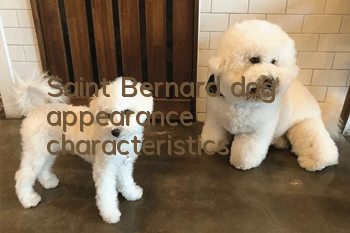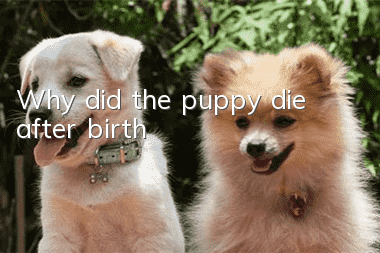Saint Bernard dog appearance characteristics

Saint Bernard is a very large dog among pet dogs, so it looks full of strength and majesty. The Saint Bernard is one of the largest pet dogs in the world, but its temperament is very docile. It has saved many people due to its large size. This dog is extremely popular in Denmark. So what are the physical characteristics of Saint Bernard? Once we know it, we can identify it, and over time we will become an expert pet.
Saint Bernard
Short-haired type
Features
Full of power, well proportioned and full in outline, every part strong and muscular, with a powerful head and a very intelligent expression. The face has a dark mask that gives the expression a stern but not vicious look.
Head
Like the body, the head appears powerful and majestic. The broad head is broad, slightly arched and sloping at the sides (upper cheekbones), forming an elegant curve with a solid outline. A deep groove starts from the base of the muzzle, passes between the eyes, and runs through the entire head. The first half is very clear, gradually disappearing into the occiput. The side lines of the head diverge from the outer corners of the eyes to the back of the head. It is ideal for the skin on the forehead, above the eyes, to have obvious wrinkles, more or less, but clear, gathering into deep grooves. When he's alert or paying attention to something, he has more wrinkles, but it doesn't create a scowl. Exaggerated wrinkles are undesirable. The transition from head to muzzle (stop) is ideally abrupt and steep. The muzzle is short, not tapered, and the vertical depth of the muzzle is greater than its length. The bridge of the nose cannot be arched or straight, and some dogs sometimes look like it is cut off. The muzzle is wide and prominent, and there is a shallow groove on the bridge of the nose from the base of the muzzle to the tip of the nose. The upper lip is very developed and cannot be very neat, but forms a graceful curve covering the lower jaw, slightly drooping. The lower lip should not hang too far down. The teeth are neat and strong, with a scissor-like bite or a pincer-like bite. Although some very good dogs will have an overshot bite, it is not ideal and an overshot bite is a fault. The roof of the mouth (ceiling) is preferably black.
Rhinoscope
Very solid, broad, with wide nostrils, like lips, which must be black.
Ears
Medium size, a higher position would be better, with well-developed edges at the base of the ears. The base of the ears stands erect on the head, so that the ears are slightly farther from the head. The ears are drooping, with the edges close to the head and not rotated. The ear wings are softly rounded and triangular, with slightly longer tips. When he is alert, the front edge of the ear is firmly against the side of the head, and the back edge is away from the head.Slightly further. If the ears rest easily on the head, with the base of the ears directly resting on the head, the head will have an oval appearance, which is very unobtrusive. On the contrary, strong ear bases will form a square head, which is broad and very eye-catching.
Eyes
Mostly forward, not on the side, medium size, dark brown, eyes intelligent, friendly, of appropriate depth. Strictly speaking, the lower eyelid cannot completely touch the eyeball, because the wrinkles of the skin will cause the eyelid to turn inward. Eyelids that droop excessively, are too red, have a thick nictitating membrane, and have eyes that are too light in color are all faults.
Neck
The position is high and very strong. When he is alert or paying attention to something, he will lift it up. At other times, it will be placed horizontally or slightly downward. There is an obvious indentation at the junction between the neck and the head. The nape muscles are very well developed and round, and the neck appears short when viewed from the side. The fat on the throat and neck is very obvious; but exaggerating it is not good.
Shoulders
Sloping, broad, very muscular and powerful, with very strong withers.
Breasts
Very well arched, with moderate depth reaching to the elbow.
Back
Very broad, very straight to the loin, with a slight sloping croup, combined with a very slight set of tail.
Hindquarters
Fully developed, leg muscles are very developed.
Abdomen
It is clearly located below the very strong waist, with a very slight lift.
Tail
The part starting from the rump is very powerful and broad, the tail is long and the tip of the tail is also very powerful. It is not considered a defect if, when resting, it hangs vertically and only the last one-third is slightly bent upward. In most dogs, the tail hangs slightly at an angle, so that it is in the shape of the letter "f". When alert, all dogs will curl up their tail to a greater or lesser extent, but it must not be raised too high or curled behind their backs. A slightly curled tail is allowed.
Forearm
Very powerful and extremely muscular.
Forearm
Straight and strong.
Hind legs
The hock angle is medium, and dewclaws are not expected. If present, they should not affect gait.
Feet
Broad, with strong toes, slightly tight toes, preferably with higher toe joints. Sometimes the appearance of dewclaws on the inside of the hind limbs is caused by bad genes. They serve no useful purpose to the dog, are not considered when judging, and are generally surgically removed.
Coat
Very dense, short (short-haired type), smooth lying, hard, but not rough to the touch. The hair on the thighs is thicker, and the hair at the base of the tail is slightly longer and denser, gradually becoming shorter toward the tip of the tail. The tail is bushy but not flag-like.
Color
White with red or red with white, red includes different concentrations of red spots and fragments, with white markings. Red and tawny are the same. The necessary markings are white chest, paws and tail tip, and a "collar" or markings on the neck, the latter and white veins on the face are ideal. There can never be just one color or no white. Faults: Any color other than a dark "mask" on the face and ears is a fault. Color can be divided into cape type and patch type.
Height at shoulders
Minimum height at withers for males is 27.5 inches; minimum height for females is 25.5 inches. The female's body structure is more beautiful and refined.
Main flaws
Any deviation from the standard is a fault, such as: concave back, disproportionate length of back, excessive hock angle, overly straight hindquarters, upward hair between toes, turned elbows, bullocks or Weak ankles.
Long-haired type
The long-haired type is roughly the same as the short-haired type, except that the hair is not short hair, but medium-length, slightly wavy hair. The hair cannot be curly or rough, especially the hair from the waist to the buttocks, which is very undulating. There is not much difference between the relatively short-haired types and only a brief explanation is needed. The hair is thick and dense, of medium length. Curly hair and flag-shaped tail are faults. The hair on the face and ears is short and soft, long hair at the base of the ears is allowed, the forelegs are lightly feathered, and the thighs are thickly haired.
- Why are there so few people raising “giant dogs”? You’ll know after watching it!
- How to stop your dog from licking people at will
- Train your dog to eat on command and train your dog to obey commands correctly!
- How to feed German Shepherd puppies?
- How to train a miniature poodle to shake hands? Let the dog listen to you!
- How to treat uterine inflammation in dogs?
- Which dogs are particularly afraid of the cold in winter?
- What is the reason why Teddy has a bulge on his eyelids?
- What should I do if I cut my dog's nails until the blood line keeps bleeding?
- What should I do if my dog doesn’t want his nails trimmed?



